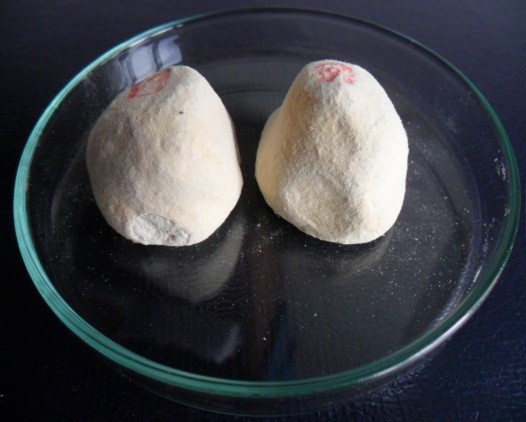ผลิตภัณฑ์ข้าวหมากแปรรูปเพื่อส่งเสริมเศรษฐกิจชุมชน
Main Article Content
Abstract
Arun Chanchaichaovivat, Penporn Chinkhamphanoa and Suwinai Kirdtabtim
รับบทความ: 31 สิงหาคม 2557; ยอมรับตีพิมพ์: 27 ตุลาคม 2557
บทคัดย่อ
การวิจัยครั้งนี้มีวัตถุประสงค์ในการแปรรูปข้าวหมากเป็นผลิตภัณฑ์หลากหลายชนิดและน่ารับประทาน โดยผลิตภัณฑ์แบ่งเป็นสองประเภทคือ ผลิตภัณฑ์แปรรูปจากเนื้อข้าวหมากและจากน้ำข้าวหมาก ได้แก่ คุกกี้ข้าวหมาก วุ้นกะทิข้าวหมาก มัฟฟินข้าวหมาก น้ำข้าวหมากผสมน้ำกระเจี๊ยบแดง น้ำข้าวหมากผสมน้ำมะตูม และน้ำข้าวหมากผสมน้ำเก๊กฮวย การประเมินความชอบของผู้บริโภคในผลิตภัณฑ์ข้าวหมากแปรรูปใช้ผู้ชิมจำนวน 30 คน ให้คะแนนในแบบสอบถาม การตรวจสอบคุณภาพข้าวหมากแปรรูปทางจุลชีววิทยาใช้วิธีตรวจหาจำนวนจุลินทรีย์ทั้งหมด ตรวจสอบการปนเปื้อนของยีสต์ รา และโคลิฟอร์ม จากผลการวิจัยพบว่า ความชอบในภาพรวมของผู้บริโภคต่อผลิตภัณฑ์คุกกี้ข้าวหมากและวุ้นข้าวหมากอยู่ในระดับมาก (ค่าเฉลี่ย = 4.46) และ มัฟฟินข้าวหมากอยู่ในระดับมากที่สุด (ค่าเฉลี่ย = 4.70) ผลการประเมินผลิตภัณฑ์แปรรูปน้ำข้าวหมาก พบว่า ผู้บริโภคมีความชอบในภาพรวมต่อผลิตภัณฑ์น้ำข้าวหมากผสมน้ำกระเจี๊ยบแดงในระดับมากที่สุด (ค่าเฉลี่ย = 4.50) น้ำข้าวหมากผสมน้ำมะตูมอยู่ในระดับมาก (ค่าเฉลี่ย =3.76) และน้ำข้าวหมากผสมน้ำเก๊กฮวยอยู่ในระดับมาก (ค่าเฉลี่ย = 4.43) การตรวจเชื้อจุลินทรีย์ในผลิตภัณฑ์แปรรูปที่เก็บไว้เป็นเวลา 9 วัน ไม่พบเชื้อเชื้อโคลิฟอร์มในผลิตภัณฑ์ข้าวหมากแปรรูปทุกชนิด ซึ่งองค์ความรู้จากการแปรรูปข้าวหมากในครั้งนี้ควรถ่ายทอดให้กับวิสาหกิจชุมชนที่ประกอบกิจการผลิตอาหารจากภูมิปัญญาท้องถิ่นเพื่อเพิ่มรายได้และส่งเสริมเศรษฐกิจชุมชนให้มีความเข้มแข็งมากขึ้น
คำสำคัญ: ข้าวหมาก ภูมิปัญญาท้องถิ่น ผลิตภัณฑ์อาหารแปรรูป เศรษฐกิจชุมชน
Abstract
This research aimed to produce variety and wholesome food products from Kaomark. Two types of food processing included products from flesh and liquid of Kaomark. Bakery and dessert products were cook from Kaomark flesh which were Kaomark cookie, Kaomark muffin and Kaomark coconut agar. Three types of soft drinks were made from fermented liquid by mixing with three kinds of herbs including Hibiscus sabdariffa L., Aegle marmelos Corr. and Chrysanthemum indicum L. Sensory evaluation questionnaires of the products were used for measuring the preference of 30 consumers. Microbiological quality was detected by total plate count, yeast and mold enumeration, and coliform test. In overall preference, the results showed that Kaomark cookie and Kaomark coconut agar were favorably for consumer with average score (mean) of 4.46. Preference of Kaomark muffin was found to be the most level (mean = 4.70). Kaomark soft drink mixed with Hibiscus sabdariffa L. was the most favorable (mean = 4.50). Soft drinks mixed with Aegle marmelos Corr. and Chrysanthemum indicum L. were lesser favorable at score of 3.76 and 4.43, respectively. In preservation of all Kaomark processing products for 9 days, coliform bacteria were not observed. For further application, the knowledge of Kaomark processing should be transferred to community enterprises that produce foods from local wisdom in order to support and strengthen their community economy.
Keywords: Kaomark, Local wisdom, Food processing product, Community economy
Downloads
Article Details

This work is licensed under a Creative Commons Attribution-NonCommercial 4.0 International License.
References
ฉัตรทิพย์ นาถสุภา. (2548). แนวคิดเศรษฐกิจชุมชน. พิมพ์ครั้งที่ 2. กรุงเทพฯ: สร้างสรรค์.
นิอร โฉมศรี. (2555). จุลชีววิทยาอาหาร. เชียงใหม่: เชียงใหม่ปรินท์ติ้ง.
ประเวศ วะสี. (2542). เศรษฐกิจพอเพียงและประชาสังคม แนวทางพลิกฟื้นเศรษฐกิจสังคม. กรุงเทพฯ: หมอชาวบ้าน.
ผานิต รุจิระพิสิทธิ์. (2549). กระบวนการผลิตน้ำผลไม้ผสมสมุนไพรจากฝรั่งและตะไคร้. วารสารวิชาการ มหาวิทยาลัยหอการค้าไทย 26(1): 183-191.
รุ่งนภา ปิตะวชิรกุล และกันต์ อินทุวงศ์. (2556).การถ่ายทอดเทคโนโลยีเครื่องแปรรูปหน่อไม้เพื่อการถนอมอาหารด้วยรูปแบบการจัดการองค์ความรู้สู่ผู้ประกอบ-การ. วารสารมหาวิทยาลัยทักษิณ 16(2): 37-43.
วิไล รังสาดทอง. (2552). เทคโนโลยีการแปรรูปอาหาร. พิมพ์ครั้งที่ 5. กรุงเทพฯ: เท็ก แอนด์ เจอร์นัล พับลิเคชั่น.
เสรี พงศ์พิศ. (2550). เศรษกิจพอเพียง เกิดได้ ถ้าใจปราถนา. กรุงเทพฯ: พลังปัญญา.
สำนักงานมาตรฐานผลิตภัณฑ์อุตสาหกรรม. (2557). รายชื่อมาตรฐานผลิตภัณฑ์ชุมชนที่ประกาศใช้. สืบค้นจากเว็บไซต์ http://tcps.tisi.go.th/public/Standard List.aspx เมื่อวันที่ 15 สิงหาคม 2557.
อรุณ ชาญชัยเชาว์วิวัฒน์ และอัฐวิทย์ อุเทนสุต. (2556). ประสิทธิภาพการยับยั้งแบคทีเรียก่อโรคทางเดินอาหารโดยแบคทีเรียกรดแลกทิกจากลูกแป้งข้าวหมาก. วารสารหน่วยวิจัยวิทยาศาสตร์ เทคโนโลยี และสิ่งแวดล้อมเพื่อการเรียนรู้ 4(2): 124-131.
Blandinob, A., Al-Aseeria, M. E., Pandiellaa, S. S., Can-terob, D., Webba, C. (2003). Cereal-based fermented foods and beverages. Food Research Inter-national 36: 527-543.
Chanchaichaovivat, A. and Pasuk, A. (2013). Inhibitory effect of fermented glutinous rice on enteropathogenic bacteria. The Journal of Interdisciplinary Networks 2 (2): 30-36.
Ghosh, K., Ray, M., Adak, A., Dey, P., Halder, S. K., Das, A., Jana, A., Parua Mondal, S., Das Moha-patra, P. K., Pati, B. R., and Mondal, K. C. (2015). Microbial, saccharifying and antioxidant properties of an Indian rice based fermented beverage. Food Chemistry 168: 196-202.
Perera, P. R. D, Ekanayake, S., Ranaweera, K. K. D. S. (2014). Antiglycation and antioxidant activities of a ready to serve herbal drink of Syzygium Cumini bark extract. Medicinal & Aromatic Plants 3(1): 148.
U.S. Food and Drug Administration (2002). Bacteriological analytical manual online (Chapter 4). Maryland: Department of Health and Human Services.
